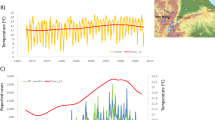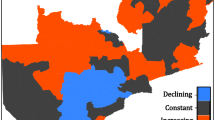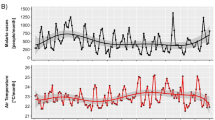Abstract
The current and potential future impact of climate change on malaria is of major public health interest1,2. The proposed effects of rising global temperatures on the future spread and intensification of the disease3,4,5, and on existing malaria morbidity and mortality rates3, substantively influence global health policy6,7. The contemporary spatial limits of Plasmodium falciparum malaria and its endemicity within this range8, when compared with comparable historical maps, offer unique insights into the changing global epidemiology of malaria over the last century. It has long been known that the range of malaria has contracted through a century of economic development and disease control9. Here, for the first time, we quantify this contraction and the global decreases in malaria endemicity since approximately 1900. We compare the magnitude of these changes to the size of effects on malaria endemicity proposed under future climate scenarios and associated with widely used public health interventions. Our findings have two key and often ignored implications with respect to climate change and malaria. First, widespread claims that rising mean temperatures have already led to increases in worldwide malaria morbidity and mortality are largely at odds with observed decreasing global trends in both its endemicity and geographic extent. Second, the proposed future effects of rising temperatures on endemicity are at least one order of magnitude smaller than changes observed since about 1900 and up to two orders of magnitude smaller than those that can be achieved by the effective scale-up of key control measures. Predictions of an intensification of malaria in a warmer world, based on extrapolated empirical relationships or biological mechanisms, must be set against a context of a century of warming that has seen marked global declines in the disease and a substantial weakening of the global correlation between malaria endemicity and climate.
This is a preview of subscription content, access via your institution
Access options
Subscribe to this journal
Receive 51 print issues and online access
$199.00 per year
only $3.90 per issue
Buy this article
- Purchase on Springer Link
- Instant access to full article PDF
Prices may be subject to local taxes which are calculated during checkout

Similar content being viewed by others
References
Patz, J. A., Campbell-Lendrum, D., Holloway, T. & Foley, J. A. Impact of regional climate change on human health. Nature 438, 310–317 (2005)
Lafferty, K. D. The ecology of climate change and infectious diseases. Ecology 90, 888–900 (2009)
McMichael, A. J. et al. in Comparative Quantification of Health Risks: Global and Regional Burden of Disease due to Selected Major Risk Factors (eds Ezzati, M., Lopez, A. D., Rodgers, A. & Murray, C. J. L.) 1543–1649 (World Health Organization, 2004)
Tanser, F. C., Sharp, B. & Le Sueur, D. Potential effect of climate change on malaria transmission in Africa. Lancet 362, 1792–1798 (2003)
van Lieshout, M., Kovats, R. S., Livermore, M. T. J. & Martens, P. Climate change and malaria: analysis of the SRES climate and socio-economic scenarios. Glob. Environ. Change 14, 87–99 (2004)
Intergovernmental Panel on Climate Change. Climate Change 2007: Impacts, Adaptation and Vulnerability. Contribution of Working Group II to the Fourth Assessment Report of the Intergovernmental Panel on Climate Change (eds Parry, M. L., Canziani, O. F., Palutikof, J. P., van der Linden, P. J. & Hanson, C. E.) (Cambridge Univ. Press, 2007)
US Environmental Protection Agency. Endangerment and Cause or Contribute Findings for Greenhouse Gases Under Section 202(a) of the Clean Air Act (Technical Support Document) (US Environmental Protection Agency, 2010)
Hay, S. I. et al. A world malaria map: Plasmodium falciparum endemicity in 2007. PLoS Med. 6, e1000048 (2009)
Hay, S. I., Guerra, C. A., Tatem, A. J., Noor, A. M. & Snow, R. W. The global distribution and population at risk of malaria: past, present, and future. Lancet Infect. Dis. 4, 327–336 (2004)
Snow, R. W., Guerra, C. A., Mutheu, J. J. & Hay, S. I. International funding for malaria control in relation to populations at risk of stable Plasmodium falciparum transmission. PLoS Med. 5, e142 (2008)
World Health Organization. World malaria report 2009 (World Health Organization, 2009)
Intergovernmental Panel on Climate Change. Climate Change 2007: The Physical Science Basis. Contribution of Working Group I to the Fourth Assessment Report of the Intergovernmental Panel on Climate Change (eds Solomon, S. et al.) (Cambridge Univ. Press, 2007)
Lysenko, A. J. & Semashko, I. N. [in Russian] in Itogi Nauki: Medicinskaja Geografija (ed. Lebedew, A. W.) 25–146 (Academy of Sciences, Moscow, 1968)
Mouchet, J. et al. Biodiversité du paludisme dans le monde [in French] (John Libbey Eurotext, 2004)
Small, J., Goetz, S. J. & Hay, S. I. Climatic suitability for malaria transmission in Africa, 1911–1995. Proc. Natl Acad. Sci. USA 100, 15341–15345 (2003)
Martens, W. J. M., Jetten, T. H. & Focks, D. A. Sensitivity of malaria, schistosomiasis and dengue to global warming. Clim. Change 35, 145–156 (1997)
Reiter, P. Global warming and malaria: knowing the horse before hitching the cart. Malaria J. 7, (Suppl. 1)S3 (2008)
Lindsay, S. W. & Martens, W. J. M. Malaria in the African highlands: past, present and future. Bull. World Health Organ. 76, 33–45 (1998)
Martens, P. et al. Climate change and future populations at risk of malaria. Glob. Environ. Change 9, S89–S107 (1999)
Smith, D. L., McKenzie, F. E., Snow, R. W. & Hay, S. I. Revisiting the basic reproductive number for malaria and its implications for malaria control. PLoS Biol. 5, e42 (2007)
Okell, L. C., Drakeley, C. J., Bousema, T., Whitty, C. J. & Ghani, A. C. Modelling the impact of artemisinin combination therapy and long-acting treatments on malaria transmission intensity. PLoS Med. 5, e226 (2008)
Smith, D. L., Hay, S. I., Noor, A. M. & Snow, R. W. Predicting changing malaria risk after expanded insecticide-treated net coverage in Africa. Trends Parasitol. 25, 511–516 (2009)
Killeen, G. F. et al. The potential impact of integrated malaria transmission control on entomologic inoculation rate in highly endemic areas. Am. J. Trop. Med. Hyg. 62, 545–551 (2000)
Kouznetsov, R. L. Malaria control by application of indoor spraying of residual insecticides in tropical Africa and its impact on community health. Trop. Doct. 7, 81–91 (1977)
Fillinger, U., Ndenga, B., Githeko, A. & Lindsay, S. W. Integrated malaria vector control with microbial larvicides and insecticide-treated nets in western Kenya: a controlled trial. Bull. World Health Organ. 87, 655–665 (2009)
Teklehaimanot, H. D., Teklehaimanot, A., Kiszewski, A., Rampao, H. S. & Sachs, J. D. Malaria in São Tomé and Principe: on the brink of elimination after three years of effective antimalarial measures. Am. J. Trop. Med. Hyg. 80, 133–140 (2009)
Kleinschmidt, I. et al. Reduction in infection with Plasmodium falciparum one year after the introduction of malaria control interventions on Bioko Island, Equatorial Guinea. Am. J. Trop. Med. Hyg. 74, 972–978 (2006)
Sharp, B. L. et al. Seven years of regional malaria control collaboration - Mozambique, South Africa, and Swaziland. Am. J. Trop. Med. Hyg. 76, 42–47 (2007)
Bhattarai, A. et al. Impact of artemisinin-based combination therapy and insecticide-treated nets on malaria burden in Zanzibar. PLoS Med. 4, e309 (2007)
Smith, D. L., Dushoff, J., Snow, R. W. & Hay, S. I. The entomological inoculation rate and Plasmodium falciparum infection in African children. Nature 438, 492–495 (2005)
Smith, D. L., Guerra, C. A., Snow, R. W. & Hay, S. I. Standardizing estimates of the Plasmodium falciparum parasite rate. Malar. J. 6, 131 (2007)
Smith, D. L. & Hay, S. I. Endemicity response timelines for Plasmodium falciparum elimination. Malar. J. 8, 87 (2009)
Guerra, C. A. et al. The limits and intensity of Plasmodium falciparum transmission: implications for malaria control and elimination worldwide. PLoS Med. 5, e38 (2008)
Diggle, P. & Ribeiro, P. J. Model-based Geostatistics (Springer, 2007)
Stein, M. L. Space-time covariance functions. J. Am. Stat. Assoc. 100, 310–321 (2005)
Antosiewicz, H. A. in Handbook of Mathematical Functions (eds Abramowitz, M. & Stegun, I. A.) 435–479 (Dover Publications, 1964)
Davis, G. M. in Handbook of Mathematical Function (eds Abramowitz, M. & Stegun, I. A.) 253–295 (Dover Publications, 1964)
Hay, S. I., Guerra, C. A., Tatem, A. J., Atkinson, P. M. & Snow, R. W. Urbanization, malaria transmission and disease burden in Africa. Nature Rev. Microbiol. 3, 81–90 (2005)
Killeen, G. F., Ross, A. & Smith, T. Infectiousness of malaria-endemic human populations to vectors. Am. J. Trop. Med. Hyg. 75, 38–45 (2006)
Acknowledgements
We thank A. Bibby, H. C. J. Godfray, G. D. Shanks and G. R. W. Wint for comments on the manuscript. S.I.H. is funded by a Senior Research Fellowship from the Wellcome Trust (#079091) that also supports P.W.G. and previously A.J.T. R.W.S. is funded by a Principal Research Fellowship from the Wellcome Trust (#079080) that also supports A.P.P. D.L.S. and A.J.T. are supported by a grant from the Bill and Melinda Gates Foundation (#49446). D.L.S. and S.I.H. also acknowledge funding support from the RAPIDD program of the Science & Technology Directorate, Department of Homeland Security, and the Fogarty International Center, National Institutes of Health. This work forms part of the output of the Malaria Atlas Project (MAP, http://www.map.ox.ac.uk), principally funded by the Wellcome Trust, UK.
Author information
Authors and Affiliations
Contributions
S.I.H. conceived the research. P.W.G. and S.I.H. drafted the manuscript. P.W.G. led, and A.P.P., D.L.S., A.J.T. and R.W.S. contributed to, the analyses. All authors discussed the results and contributed to the revision of the final manuscript.
Corresponding authors
Ethics declarations
Competing interests
The authors declare no competing financial interests.
Supplementary information
Supplementary Information
This file contains Supplementary Information on (A) the weakening geographical relationship between climate and malaria endemicity 1900-2007 and (B) estimating changing endemicity in terns of PfR0 effect size, Supplementary References, Supplementary Figures S1-S2 with legends and Supplementary Tables S1-S3. (PDF 644 kb)
PowerPoint slides
Rights and permissions
About this article
Cite this article
Gething, P., Smith, D., Patil, A. et al. Climate change and the global malaria recession. Nature 465, 342–345 (2010). https://doi.org/10.1038/nature09098
Received:
Accepted:
Issue Date:
DOI: https://doi.org/10.1038/nature09098
This article is cited by
-
Predicting malaria risk considering vector control interventions under climate change scenarios
Scientific Reports (2024)
-
Dynamics analysis of a reaction-diffusion malaria model accounting for asymptomatic carriers
Zeitschrift für angewandte Mathematik und Physik (2024)
-
Malaria, climate variability, and interventions: modelling transmission dynamics
Scientific Reports (2023)
-
Potential future malaria transmission in Odisha due to climate change
Scientific Reports (2022)
-
Malaria elimination on Hainan Island despite climate change
Communications Medicine (2022)
Comments
By submitting a comment you agree to abide by our Terms and Community Guidelines. If you find something abusive or that does not comply with our terms or guidelines please flag it as inappropriate.



